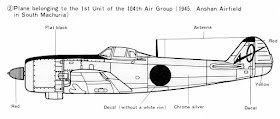The next aircraft is number 2 in the Tamiya instructions, "plane belonging to the 1st Unit of the 104th Air Group (1945. Anshan airfield in South Machuria (sic))"
We have discussed the history of this unit in an older posting, HERE, so we will see here the various problems arising from these two very well known and ostensibly "easy" photos which are the source for the Tamiya suggestion.
 |
| Photo Credit: "Japanese Military Aircraft Illustrated Vol. 1", Bunrindo |
 |
| Photo Credit: "Gakken #46" |
First of all, although both photos were taken at the same place and time, the various sources do not seem to agree where these two photos were actually taken. Aerodetail for example agrees with Tamiya and mentions that the aircraft in the photos were in "Anshan A/B Manchuria" while others like Revi mention "photographed by a military doctor at Ota which was the factory airfield of Nakajima".
The older FAOW#148 (1985) says "Anshan", the later FAOW#19(1989) and Model Art#493 says Ota and Gakken #46 also agrees. I too believe these two photos were taken at Ota. According to Gakken these "Hayate" from the 104 were returned to Nakajima a few days before the end of the war; the exact reason and the details are unknown. They could not have been flown after the end of the war as all flights of Japanese aircraft were explicitely forbiden by the Allies; anything bearing hinomaru would have been shot down.
The overall NMF "Hayate" of the Tamiya instructions was a Ki-84 Otsu with 2X20mm Ho-5 cannons in the fuselage and a slightly larger gas exit right behind the top engine exhaust.
According to Gakken, NMF "Hayate" were sometimes obtained by units when pilots went to the Nakajima factories and got the planes before even having been test flown, as we saw with the 102 Sentai in another posting.
Let's see now how this particular aircraft has been depicted by artists starting with the Bunrindo publication.
The silver looks absolutely amazing in these old publications but the colors of the various markings are more psychedelic than accurate.
Nohara Shigeru in the Aerodetail publication offers a more accurate depiction.
Nevertheless he hasn't noticed that the wing tip is in red, something quite clear in the photo.
Katabuchi Sunao in Gakken is much better. Note that the radio mast behind the canopy is correctly portrayed in dark color both below and above; a detail not immediately clear in the Tamiya instructions.
The Kagero illustrator (Arkadiusz Wrobel?) follows the example of Gakken but the colors as they look in print are too lifeless and drab for my taste. Notice that the caption says "Anshan".
I would disagree with the last two illustrators regarding the color of the spinner, though. On closer inspection it looks to be painted in exactly the same color of the propeller, i.e. green.
Therefore, in my opinion, all the above artists got something wrong with this aircraft.
Devlin Chouinard didn't miss the chance to send artwork that is the most accurate I've seen.
Note that the fabric surfaces are a dull gray as an aircraft without a proper paint job would look like. It is of interest that fabric surfaces on the NMF "Hayate" show very slight color difference with the metal surfaces suggesting that they were not painted hairyokushoku as on "Hayabusa".
Note that the fabric surfaces are a dull gray as an aircraft without a proper paint job would look like. It is of interest that fabric surfaces on the NMF "Hayate" show very slight color difference with the metal surfaces suggesting that they were not painted hairyokushoku as on "Hayabusa".
Let's turn our attention to the other aircraft in the two photos.
The Gakken and Kagero illustrations are very accurate in every respect including the yellow wing tip.
Nevertheless my most favorite illustration is by Zdeněk Macháček (thank you Peter) and can be found in the book "Japanese WWII Aircraft in Color (Volume 1)" by Martin Ferkl and published by REVI in 2006. A very very highly recommended publication in every respect including the decals.
While the "Hayate" in most units were called by the last digits of their serial number (ex. "today I'll fly the 46"), most, if not all, the planes of the 104 Sentai got a certain name. There were three "tai" (sub-units?) within the 104. The 3rd Tai used one or two kanji to name their planes relative to the hometown names of the pilots. The 1st and 2nd Tai used one kanji.
On the fuselage of the second "Hayate", in "olive drab", two kanji can be seen on the fuselage side under the canopy, 益城, and they read "Mashiki", a town in Kumamoto Prefecture, here, the birthplace of the pilot.
According to Gakken the NMF "Hayate" probably had the kanji 肇, "Hajime" (meaning start, beginning or the first name of the pilot) written on the fuselage. Other 104 "Hayate" with one kanji had names like "Red", "Blue" and others.











Another great post! I guess I will have to take out my finished 104th Sentai Hayate and paint the wing tips red.
ReplyDeleteWind Swords
Thank you, G. Yes, another great post!
ReplyDeleteHi, the artwork from mr.Ferkl book was drawn by Zdeněk Macháček an czech native illustrator known for his work in Revi publications and for cover artworks for several czech kit manufacturers.
ReplyDeleteGreat job with the article! :)
Greetz